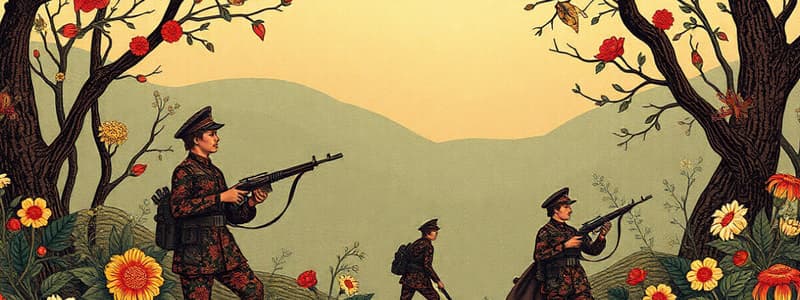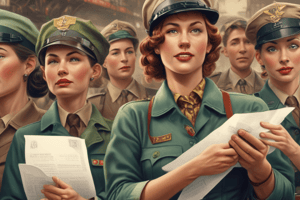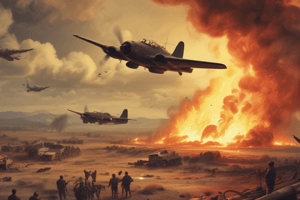Podcast
Questions and Answers
What year did World War II begin?
What year did World War II begin?
- 1940
- 1941
- 1939 (correct)
- 1942
The United States entered World War II immediately after the attack on Pearl Harbor.
The United States entered World War II immediately after the attack on Pearl Harbor.
False (B)
What was the name of the German military strategy that involved a rapid and overwhelming attack by mechanized forces?
What was the name of the German military strategy that involved a rapid and overwhelming attack by mechanized forces?
Blitzkrieg
What was the primary goal of Hitler's policies in eastern Europe?
What was the primary goal of Hitler's policies in eastern Europe?
Which of these is NOT an example of a major battle or campaign fought by Allied forces during World War II in Europe?
Which of these is NOT an example of a major battle or campaign fought by Allied forces during World War II in Europe?
The Allied victory in World War II was a significant turning point in the history of the ______.
The Allied victory in World War II was a significant turning point in the history of the ______.
What was the name of the secret code-breaking program that provided valuable intelligence to Allied forces during World War II?
What was the name of the secret code-breaking program that provided valuable intelligence to Allied forces during World War II?
The Allied invasion of Normandy was the first major amphibious operation in World War II.
The Allied invasion of Normandy was the first major amphibious operation in World War II.
Match the following Allied commanders with their respective theaters of operation during World War II:
Match the following Allied commanders with their respective theaters of operation during World War II:
What was the name of the strategically important island in the Pacific that was a key objective for both the United States and Japan during the war?
What was the name of the strategically important island in the Pacific that was a key objective for both the United States and Japan during the war?
What was the primary reason for the Japanese attack on Pearl Harbor?
What was the primary reason for the Japanese attack on Pearl Harbor?
What were the primary challenges faced by American forces during the battles in the dense jungles of Papua and Guadalcanal?
What were the primary challenges faced by American forces during the battles in the dense jungles of Papua and Guadalcanal?
The Japanese military relied on deception and counterattacks to achieve their victories in the Pacific theater.
The Japanese military relied on deception and counterattacks to achieve their victories in the Pacific theater.
What is the term for the kamikaze suicide attacks carried out by Japanese aviators during World War II?
What is the term for the kamikaze suicide attacks carried out by Japanese aviators during World War II?
What was the codename for the Allied campaign that involved the invasion of Normandy, France?
What was the codename for the Allied campaign that involved the invasion of Normandy, France?
What was the primary objective of the Allied forces in the final offensive in Europe?
What was the primary objective of the Allied forces in the final offensive in Europe?
What were the primary challenges faced by Allied forces in the mountainous terrain of Italy?
What were the primary challenges faced by Allied forces in the mountainous terrain of Italy?
Which of these was a major factor leading to the development of American amphibious warfare techniques during World War II?
Which of these was a major factor leading to the development of American amphibious warfare techniques during World War II?
The United States remained largely uninvolved in international affairs before the outbreak of World War II.
The United States remained largely uninvolved in international affairs before the outbreak of World War II.
What was the name of the agreement reached between Germany and the Soviet Union in 1939 that allowed for the division of Poland between them?
What was the name of the agreement reached between Germany and the Soviet Union in 1939 that allowed for the division of Poland between them?
What was the primary military objective of the United States in the Pacific theater during World War II?
What was the primary military objective of the United States in the Pacific theater during World War II?
Which of these events marked a significant turning point in the Pacific war in favor of the Allies?
Which of these events marked a significant turning point in the Pacific war in favor of the Allies?
What was the name of the island in the Pacific that was a key battleground for the fight against Japanese forces and marked the end of Japanese resistance in the Pacific theater?
What was the name of the island in the Pacific that was a key battleground for the fight against Japanese forces and marked the end of Japanese resistance in the Pacific theater?
The atomic bombings of Hiroshima and Nagasaki were the decisive factor in Japan's surrender.
The atomic bombings of Hiroshima and Nagasaki were the decisive factor in Japan's surrender.
Flashcards
World War II
World War II
The largest global armed conflict, occurring from 1939 to 1945.
U.S. Army's role
U.S. Army's role
The U.S. Army fought against Axis powers, mainly Germany and Japan, during World War II.
Blitzkrieg
Blitzkrieg
A method of warfare using fast and powerful attacks with combined arms.
Lend-Lease Act
Lend-Lease Act
Signup and view all the flashcards
Battle of Britain
Battle of Britain
Signup and view all the flashcards
D-Day
D-Day
Signup and view all the flashcards
Pearl Harbor
Pearl Harbor
Signup and view all the flashcards
Battle of Midway
Battle of Midway
Signup and view all the flashcards
North African Campaign
North African Campaign
Signup and view all the flashcards
Kasserine Pass
Kasserine Pass
Signup and view all the flashcards
Operation Overlord
Operation Overlord
Signup and view all the flashcards
Strategic Bombing Campaign
Strategic Bombing Campaign
Signup and view all the flashcards
Nuremberg Trials
Nuremberg Trials
Signup and view all the flashcards
Amphibious Warfare
Amphibious Warfare
Signup and view all the flashcards
Island Hopping
Island Hopping
Signup and view all the flashcards
Atomic Bomb
Atomic Bomb
Signup and view all the flashcards
Rationing
Rationing
Signup and view all the flashcards
War Bonds
War Bonds
Signup and view all the flashcards
Cold War
Cold War
Signup and view all the flashcards
The Home Front
The Home Front
Signup and view all the flashcards
V-E Day
V-E Day
Signup and view all the flashcards
Hitler's Rise to Power
Hitler's Rise to Power
Signup and view all the flashcards
Holocaust
Holocaust
Signup and view all the flashcards
Totalitarianism
Totalitarianism
Signup and view all the flashcards
Axis Powers
Axis Powers
Signup and view all the flashcards
Allied Powers
Allied Powers
Signup and view all the flashcards
War in the Pacific
War in the Pacific
Signup and view all the flashcards
Italian Campaign
Italian Campaign
Signup and view all the flashcards
Propaganda
Propaganda
Signup and view all the flashcards
Study Notes
Introduction
- World War II was the largest and most violent armed conflict in history
- The half-century since the war has diminished collective knowledge about the conflict
- The political, social, and military implications of WWII are highly relevant today
- The US Army's participation in WWII is worth studying for insight into military preparedness, global strategy, and combined operations
- The US Army will commemorate the 50th anniversary of WWII
The War in Europe
- World War I left questions of European dominance unresolved
- The 1929 Depression devastated democratic regimes, including the German one, with the rise of the Nazi Party and Adolf Hitler
- Hitler aimed to overturn the Treaty of Versailles, expand German territory, and secure "living space" for Germans
- Hitler formed an alliance with Italy's Mussolini (Axis)
- Japan, an industrial power in the Far East, sought resources of China and Southeast Asia
- This raised conflict with European and American colonial powers
- The League of Nations failed to halt aggression in Manchuria
The Outbreak of War
- Hitler's expansionist policies led him to seize Austria in 1938
- The Munich Pact allowed for the annexation of Czechoslovakia
- Hitler's invasion of Poland marked the beginning of WWII, with Britain and France declaring war on Germany
Allied Operations in WWII (1942-1945)
-
Europe
- North African Campaign: Allied forces invaded North Africa in 1942 under Eisenhower
- German efforts to seize Allied supply lines were stopped at El Alamein
- Allies successfully invaded Sicily to open access to the Italian mainland
- The Italian campaign turned into a brutal and costly struggle against German resistance, with the Allies eventually capturing Rome.
- Cross-Channel Attack: The Normandy landings (Operation Overlord) in June 1944 marked a pivotal invasion of German-held France
- The Allied forces faced considerable early German resistance in heavy hedgerow fighting but eventually broke through and liberated France.
- Battles of Attrition: Fierce battles ensued throughout occupied Europe -The battle for Normandy was particularly hard fought, with many casualties on both sides. -The Ardennes Offensive (Battle of the Bulge): Germans launched a massive counterattack that caught Allies off guard in the winter of 1944-45
- The Final Offensive: Eisenhower planned a coordinated assault on multiple fronts to overwhelm the German forces. -The Allies eventually pushed into Germany, crossed the Rhine, and liberated parts of the country. The Germans surrendered in May 1945.
-
Pacific
- The attack on Pearl Harbor provoked American entry into WWII in December 1941. - Initially, Japan rapidly expanded across the Pacific, conquering territories like the Philippines and other locales.
- The Battle of Midway in 1942 was a turning point of the war in the Pacific
- The Allied forces began an island-hopping campaign to reclaim Japanese-held islands. It involved amphibious operations, aiming to bypass heavily fortified Japanese islands.
- The tide turned dramatically in 1943-45 in the Pacific as American forces pushed toward Japan, culminating with atomic bombings of Hiroshima and Nagasaki in August 1945. Japan ultimately surrendered.
The Pacific War
- The Japanese advance into the Pacific was initially rapid and successful, leading to the occupation of much of Southeast Asia.
- The Pacific theater was fundamentally different from the European one, with naval and air power, rather than vast ground forces, more important.
- island-hopping campaigns were employed
- -These campaigns focused on securing key islands to set up forward bases to reach Japan.
- The development of the atomic bomb and the use on Japan in 1945 led to the end of the war.
Aftermath
- The US emerged with global military commitments and the occupation of Germany and Japan
- Demobilization of the US military occurred but was difficult, with postwar tensions.
Studying That Suits You
Use AI to generate personalized quizzes and flashcards to suit your learning preferences.




